Category — activism
The center will not hold
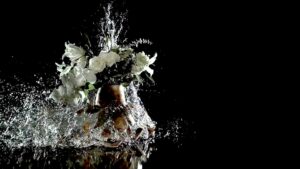
The revolution will not be televised
You will not be able to stay home, brother
You will not be able to plug in, turn on and cop out
You will not be able to lose yourself on skag
And skip out for beer during commercials, because
The revolution will not be televised
The revolution will not be right back
After a message about a white tornado
White lightning, or white people
You will not have to worry about a dove in your bedroom
The tiger in your tank, or the giant in your toilet bowl
The revolution will not go better with Coke
The revolution will not fight germs that may cause bad breath
The revolution will put you in the driver’s seat
The revolution will not be televised
Will not be televised
Will not be televised
Will not be televised
The revolution will be no re-run, brothers
The revolution will be live
I am excerpting from Gil Scott-Heron’s extraordinary poem and song recorded in 1970 during a moment in time that in some ways was entirely different than now. And in some ways just the same. The poem is about racial inequality, about anger, about taking to the streets. It is about action. Change happens not from a distance. We don’t watch it on a screen. Or follow it on Twitter. It unfolds, as Scott-Heron writes, live.
For me, “live” doesn’t necessarily mean in the streets, although that is good too. Good for, as they say, “optics.” Optics are good for a news cycle or two. Or even a month or two. But what endures is what happens away from the cameras, in the trenches. In the trenches is the hard, grinding work of systemic reform, of changing policies, of enacting legislation with teeth, of reformulating budgets, of supporting and electing leaders with integrity, compassion and vision. (By that latter I don’t just mean “vote.” I mean work for–or become–a leader, a listener, a policymaker who can make a difference.)
In the trenches is where we rethink our collective definition of “to serve and protect.” It is where we do the sweaty work of confronting and learning from the past, opening our eyes (and hearts) to the present and learning to become what we are capable of becoming: A people who care about each other. An inclusive, egalitarian democracy.
Turning and turning in the widening gyre
The falcon cannot hear the falconer;
Things fall apart; the centre cannot hold;
Mere anarchy is loosed upon the world,
The blood-dimmed tide is loosed, and everywhere
The ceremony of innocence is drowned;
The best lack all conviction, while the worst
Are full of passionate intensity.
Surely some revelation is at hand…
(William Butler Yeats, 1920)
June 10, 2020 No Comments
Two ears. One mouth.
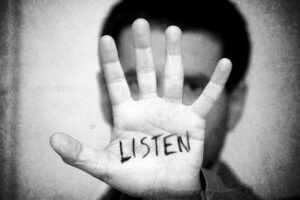
The impulse is to speak. To be outraged. To be supportive. To school others. To chime in with what we know or think we know. To use these voices that we are so accustomed to using that we have forgotten they come from privilege.
It is time to listen.
“When you talk, you are only repeating what you already know. But if you listen, you may learn something new.”
Dalai Lama
“One of the most sincere forms of respect is actually listening to what another has to say.”
Bryant H. McGill
“Instead of talking in the hope that people will listen, try listening in the hope that people will talk.”
Mardy Grothe
“Listening is being able to be changed by the other person.”
Alan Alda
“We have two ears and one tongue so that we would listen more and talk less.”
Diogenes
“Never miss a good chance to shut up.” Will Rogers
June 3, 2020 2 Comments
Own it

We have to own it.
No more railing against those other people in other places who say and do those things we cannot believe they do. No more shock about the man who golfs and tweets as the death toll exceeds 100,000. No more astonishment over the spinelessness of that man’s party. No more channeling anger into posting horrific memes and upsetting images. No more gasping at what we have become. No more paralyzing grief.
It is our country that is tearing itself apart. It is our country. It is us. Maybe we believe ourselves to be the good ones, the righteous ones, the enlightened ones, the rational ones. But we are citizens of a country that has enshrined privilege and institutionalized inequality and elected and kept in power a monster.
This country is what we have allowed it to be, what we have—maybe silently, maybe unknowingly, maybe lazily—colluded in it becoming. And now we are horrified.
It is not aliens from another planet who have, overnight, transformed medically-endorsed mask-wearing into a divisive political statement. It is not a secret army of the brainwashed who arm themselves with assault rifles and march on state capitals, who hang their governors in effigy, who flock to the beaches to revel, ass to elbow, as the virus spreads. It. Is. Us.
To quote the Turkish proverb: ‘When the axe came into the forest, the trees said, “The handle is one of us.”
These people, this president, they are us. And the sooner we realize that, the sooner we stop feeling special and above-it-all and oh-so-woke, the sooner we stop feeling smug, the sooner we can take real meaningful action. Maybe we are not part of the problem. But we sure as hell are not (yet)–not vibrantly, powerfully, whole-heartedly–part of the solution.
Let’s stop gasping and start acting.
May 27, 2020 3 Comments
The broken world awaits
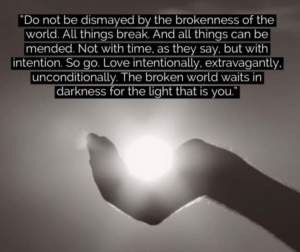
After the long weeks of baking sourdough bread and cleaning out closets and giving over our lives to zoom are history, will we be changed? Will we have been have genuinely, permanently shaken out of our everydayness?
How much of what we are learning about our country, our leaders, our communities—and most of all, about ourselves—will endure after this crisis has passed?
Will we be ready to re-think, to reach out, to take action?
I hope so. I tell myself this is possible. I tell myself…
–that the pandemic has shown us what real leadership looks like, that we do not have it in Washington, D.C. And we have an opportunity to change this in just a few months.
–that the pandemic has shown us how crucial fully vetted, authenticated, factual information is to making informed decisions. And that we owe it to the failing health of our democracy to support trusted information sources.
–that the pandemic has reminded us—in case we forgot–that the deep economic and racial inequities in our country play out in life and death. And that we can do something about this by making health care a right not a privilege.
–that the pandemic has shown a bright light on the dangerous, overcrowded, toxic warehouses we operate as prisons and jails. And that we can do something about this with intelligent, rational, fact-based, humane prison reform.
–that the pandemic has shamed us about our attitudes toward and treatment of the elderly and fragile in our midst. And that we can rethink and reform the “industry” that has been built around the warehousing of our elderly.
–that the pandemic has shown us that climate change is not an insolvable problem. The earth is resilient in a way we did not appreciate. Now we know. And we can create environmental policies with great optimism.
–that the pandemic has shown us that an emotionally and psychologically healthier way to live is to embrace internal rather than external motivation for our behavior and actions. External motivation are acts done to receive external reward (money, power, fame, the acknowledgement of others). Internal motivation is behavior done for its own sake, personally rewarding (from sourdough bread baking to sewing masks for health care workers). This inspiration, which comes from within, is more forceful. Its results more fulfilling. We’ve learned that these past two months, haven’t we?
Onward, my friends, onward.
May 20, 2020 1 Comment
Risk and Resilience
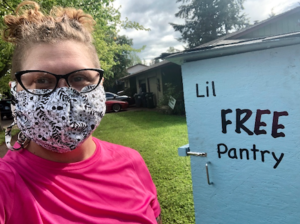
I’ve been thinking (and talking and writing) a lot these days about the “lessons” we are–or should be–learning from this pandemic. For example:
Don’t empower and support an aggressively ignorant, amoral sociopath to be your leader in time of crisis. Or any time.
Don’t treat the elderly as if their lives don’t matter. Don’t warehouse them in “facilities” and then underpay and undervalue those who care for them.
Don’t incarcerate 2.3 million people and crowd them into unsafe, unhealthy, hostile places that are cages within cages.
Don’t ignore the horrible irony of asking people to #stayhome when more than 4 million people are homeless.
We are learning other lessons too. We are learning how compassionate and generous people are. And we are learning how nasty and stupid people can be. We hear about the owners of shuttered restaurants cooking and delivering meals to health care workers. We see protestors with Nazi signs and assault rifles calling for “business as usual” on the steps of state capital buildings. We learn of teachers making daily calls to every one of their students to check up on them. We read about the murder of a security guard at a Family Dollar Store, shot after denying entry to an unmasked customer. We are learning who we are, for better and worse.
I think there is also a long-term lesson to be learned about R&R. No, not Rest and Relaxation. I mean Risk and Resilience.
We are living through a time of great risk. This is not just risk to our physical health but also to our emotional and psychological well-being. And it is not just a risk to our personal health but to the moral health of our nation.
One response to risk is fear. (This shuts down meaningful thought and thoughtful action. Another response is claiming victimhood. (Surely someone is responsible for putting me at risk. Who’s to blame?) Another is purposeful, aggressive ignorance. (Risk? What risk? I am okay. That’s what matters.)
I would like to suggest another response: Resilience. This is a mindset that empowers us to see ourselves as actors who make things happen, not victims to whom things happen. Resilience is the ability to bend, to remain supple and flexible, to spring back. Resilience means developing goals instead of focusing on barriers. It means recovering by taking clear-headed, decisive action.
Resilience, say those who study it, is a combination of optimism and endurance. Optimism is not a looking-at-the-world-through-rose-colored-glasses thing. It’s more a belief in your own efficacy. And endurance is not some nose-to-the-grindstone slog through change and challenge. Endurance is what naturally occurs when you have–and decide to pursue–a worthy goal. All of this can be learned. Yes, learned.
And this pandemic, this crisis, is a perfect opportunity for us to do so. As individuals. And as a nation.
What is your resilient response? What should be our country’s?
The image above is of (and taken by) my friend, my Food for Lane County Dining Room colleague, and one of the most resilient, generous and loving people I know, Angie Godlasky. Among her many resilient responses is this pop-up pantry in her front yard that offers free food for those in need.
May 6, 2020 1 Comment
Old. Dead.
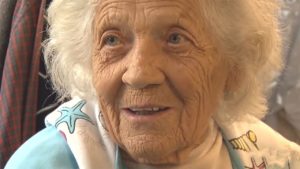
About a fifth of U.S. virus deaths are linked to long-term care facilities for the elderly.
Nursing homes are, in the words of one health official, “death pits.” (You may recall, in a previous post, I quoted another health official calling prisons in the time of covid, “petri dishes.”)
The news from nursing homes, assisted living and memory care facilities, and other places where the sick and the elderly are housed is grim. As the New York Times reports: 72 long-term care facilities in New York have had five or more deaths; infections have broken out in 394 long-term care facilities in New Jersey; 24 people at a facility in Maryland have died; more than 100 residents and workers have been infected at another in Kansas; and people have died in centers for elderly military veterans in Florida, Nevada, New York, Maine, Massachusetts, Oregon and Washington.
There’s a lot to untangle about this.
One obvious thing: This virus, like pretty much any disease, takes hold among vulnerable, medically compromised people. Healthy older people (of which there are millions) don’t live in assisted living. Frail and fragile older people do. Contagious diseases of all kinds make their way through these places quickly and devastatingly. So there’s that.
There’s also the way these places are designed. I’m not talking about the estate-like, private-apartment, gated-community housing for the wealthy (healthy) elderly. I’m talking about small, confined settings like nursing homes and memory care facilities where people live sometimes two to a room, where they sit together in small common areas all day, eat together clustered at tables. There is no social distancing. These places are not constructed in a way that makes that possible.
But there’s something else at work here, not so far beneath the surface.
First: THIS IS HOW WE TREAT OLDER PEOPLE in our culture. We warehouse them. We create confined, segregated spaces for them. And we don’t pay attention unless something terrible happens in those confined spaces.
And, we do this, we warehouse our elderly, because of our attitudes toward aging and the aged: They are useless. They are a drain. They are in the way.
And the warehouses we create are breeding grounds for disease not just because of how they are constructed but also because of how we treat the people who work at these facilities.
I know. I worked at an Alzheimer’s care facility for four months. My minimum-wage job did not include insurance (no surprise there). But it also did not include any provision for sick days. It was not just that there were no paid sick days. It was that sick days were NOT ALLOWED. If you were ill, you had the responsibility of finding a replacement. If you didn’t find someone to cover your shift, you risked being fired. If this happened twice, you were fired.
But mostly, if you were sick, you came in to work. You could not afford to stay home. Many women I worked with chose employment at this particular facility because it was on a bus line. They could not afford a working automobile. Or gas if they had one. Many were on food assistance even though they worked fulltime. That’s how we value the people who care for our sick elderly. Because that’s how we value our elderly.
This pandemic with its death toll challenges us, compels us to examine our attitudes toward the elderly, how we treat them and how we treat those who care for this. Let some good come of this.
*image is not of a person who died. I chose this because I wanted us to LOOK at the face of the elderly.
April 22, 2020 No Comments
Life inside in the time of COVID

As of last night there were eight confirmed cases of covid-19 in Oregon prisons: three staff members at the Oregon State Penitentiary and three inmates and two staff members at Santiam Correctional Institution.
Everyone knew this was coming. And no one expects this will be the end. It is the beginning. Prisons are, in the words of public health experts, “petri dishes.”
On Monday, the Oregon Justice Resource Center along with two attorneys as co-counsel filed a class action suit against the Oregon Department of Corrections and Governor Kate Brown. The suit alleges that inmates’ rights are being violated by the “willful and/or deliberately indifferent medical care provided to them.” The seven members of the class action are all older than 60 and/ or have chronic health concerns that put them at additional risk.
This is from the Oregon Justice Resource Center’s announcement of the suit:
The plaintiffs are concerned that COVID-19 poses a serious risk to the health of all who live and work in Oregon’s prisons. There are many reasons why incarcerated people and those who work with them may be especially vulnerable to outbreaks of infection, including living at close quarters to one another, unsanitary conditions, poor health, and the large numbers of people who cycle through the system. Prisons are not built to adequately withstand a global pandemic; ODOC is not equipped or resourced to handle a public health crisis of this magnitude.
What’s happening inside? Here are three examples, according to first-hand information gathered by the OJRC:
An inmate in one prison became “very ill” with fever, dry cough, lethargy. He was denied a COVID-19 test. He was quarantined but still required to take his meals with the general population.
An inmate in another prison is housed in a dorm with 117 other women where the beds are three feet apart. Forty of the women have health conditions that put them at additional risk from COVID-19.
An inmate at another prison is on the hazard clean-up crew and has received to training or protective gear other than gloves. The disinfectant he is required to use is not an EPA-registered disinfectant effective against the virus that causes COVID-19.
Whatever is happening in our own stay at home/ mask up/ wash your hands lives, we might want to take a moment to think about the lives of the 2.3 million people incarcerated in American prisons and jails.
*Excerpt from a poem written by “Ted Point,” one of the men in my Lifers’ Writers Group at Oregon State Penitentiary
April 8, 2020 No Comments
Prisons and COVID-19
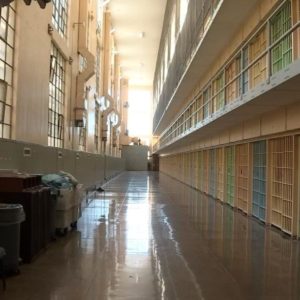
This morning began with the distressing—but completely expected—news of the first confirmed case of corona virus at an Oregon prison. The person is an employee at Oregon State Penitentiary in Salem, the state’s only max, where more than 2000 men live—most doubled-up in cells meant for one person, cells the size of your bathroom. This is the prison I know well, having spent more than four years as a volunteer there running a writers’ group for Lifers. I went in and out of that prison close to 100 times. I was there early last month visiting an inmate. Two days later, in response to the virus threat, the Department of Corrections closed all the prisons and jails in the state to visitors.
That was a smart move. However, as everyone familiar with this prison knows, OSP houses the state’s second largest commercial laundry, which receives thousands of tons of dirty linen from state hospitals and other institutions. It is unclear what precautions, if any, were taken in response to the threat.
But the virus entered the prison through an employee. With more than 4,500 people working for the Department of Corrections, many hundreds of them staffing three shifts at OSP, the virus has had so many opportunities to enter that it is surprising it took this long. The place is on lockdown as of this morning. That means everyone is confined to their cell 24/7 (except…if this lockdown is like the others…those inmates who work for the laundry).
In a letter to the director of the Department of Corrections, Colette Peters, officials with ACLU Oregon, the Oregon Justice Resource Center, Oregon Criminal Defense Lawyers Association, Partnership for Safety & Justice and Sponsors, Inc., asked her to reduce the prison population by considering people for early release.
“Given the mortality rate associated with the virus, we are concerned about the virus’s spread to at-risk people, particularly the elderly, within the closed confines of a prison setting,” they said in the letter. (Please see ACTION item at the bottom of this post.)
A 2012 study by the ACLU found that Oregon had the ninth-largest population of senior-aged prisoners in the United States, despite being only the 27th largest state by population. Research also shows that people in prison have higher rates of “co-morbidities,” those conditions (diabetes, heart disease, asthma) that make a person more vulnerable to the virus and far more likely to die from it.
If you have been tracking news about the virus and prisons, you know that Cook County Jail (Chicago) has recently reported at least 113 cases involving both inmates and staff. In the federal system, at least 52 inmates and prison workers across the U.S. have tested positive, including a cluster at the federal prison in Atlanta.
A worker there (speaking on condition of anonymity, fearing retaliation) made this point: “We do not have enough masks; we do not have the supplies needed to deal with this. We don’t have enough space to properly quarantine inmates.”
This would be true across ALL prisons and jails. These places where we warehouse 2.3 million people are, in the words of epidemiologists tracking the pandemic, “petri dishes.”
PROTECT OREGON INMATES FROM CORONAVIRUS (COVID19)
Please email, call, Tweet, mail
Governor Kate Brown:
Twitter @OregonGovBrown
900 Court Street, Suite 254, Salem, OR 97301, Phone: 503-378-4582
April 1, 2020 4 Comments
We care
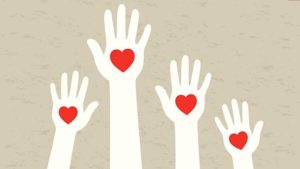
“In every crisis, doubt or confusion, take the higher path
– the path of compassion, courage, understanding and love.”
― Amit Ray
Yes, there is the guy who drove around Chattanooga buying every bottle of hand sanitizer on the shelves at Dollar Tree, Walmart, Staples Home Depot, and then, having created a shortage, took to the highway with a loaded UHaul price-gouging his own community. Yes, there are the hucksters who rushed to the internet to sell flimsy, useless face masks. Yes, there is panic-buying, hording—even fighting—in grocery stores.
But, my friends, there is also generosity and compassion, thoughtfulness and community-mindedness. There are humans being kind to humans. Because, despite the White House-fueled incivility and vitriol that has become the “new normal,” despite the real and evolving health (and attendant financial) crisis posed by the coronavirus, this is what we humans do. We care about—and for—each other.
Let’s take a moment to recognize, celebrate and support the generous and compassionate actions of others, both big and small.
In Eugene, Bagelsphere is home-delivering a dozen bagels for free to any senior who cannot or does not want to risk going out to shop.
Eugene-based Oregon Community Credit Union (owned by more than 150,000 members) has told its mortgage customers that they can skip April payment with no penalty or fees.
Laughing Planet is offering free meals to school kids on meal assistance programs at all its Pacific Northwest locations.(Students are not required to show proof that they are part of a meal program.) In Lincoln City, OR, Grill 1646 is giving away hotdogs and PB & J’s to homeless students who will be unable to get free meals due to school closures.
Shine Distillery and Grill in Portland is making its own hand sanitizer and giving it away for free. (The product comes from the process of distilling their own spirits.)
Seattle-based REI has closed all its retail stores—and will continue to pay all its employees during the closure.
Trader Joes has expanded its paid sick time to all of crew members.
And then there are the grander gestures:
Zion Williamson, the 19-year-old superstar of the Pelicans basketball team, announced that he will cover the salaries of all laid-off workers at the Smoothie King Center in New Orleans for the next month.
That’s the most dramatic move in the world of professional sports, but the following teams have also pledged to support the (mostly hourly-paid) stadium and arena workers out of work due to game and tournament cancellations: Dallas Mavericks, Houston Astros, Indiana Pacers, LA Clippers, LA Lakers, Golden State Warriors, Miami Heat, Milwaukee Bucks, Detroit Pistons, Chicago Bulls, Cleveland Cavaliers, Brooklyn Nets, Atlanta Hawks…the list goes on.
Renowned Washington, D.C chef and restaurateur José Andrés announced that he was transforming some of his restaurants into community kitchens to offer lunches for those in need of a meal.
What is happening in your community? How can you help?
March 18, 2020 No Comments
Keep It Moving
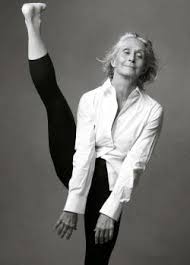
Keep It Moving is Twyla Tharp’s newest book. Nearing 80, vibrant and productive, a creative tornado, a no-nonsense powerhouse, she ruminates on how to live with purpose as time passes.
After the first chapter, gloriously and emboldenly entitled “Take Up Space,” the book devolves into mostly standard generic self-help advice (e.g. take care of your body, take risks, build resilience, etc.). But because it is coming from Twyla Tharp, a woman of enormous energy and extraordinary vitality, it feels authentic (not to mention hard-won), imbued with a deep wisdom—and an engagingly stern attitude—missing from other such “literature” like those perky women’s magazine columns or those mountains of follow-this-fad books.
But it is not the nothing-new-here advice, or the little exercises (I don’t mean push-ups) she offers that has stayed with me, that I want to pass along to you. It is these statements.
To look back is to cling to something well over and behind you. We don’t lose youth. Youth stays put. We move on.
Age is not the enemy. Stagnation is the enemy. Complacency is the enemy. Stasis is the enemy.
Choose to make your life bigger. Opt for expression over observation, action instead of passivity, risk over safety, the unknown over the familiar. Be deliberate. Act with intention.
Evaluate your accomplishments as beginnings rather than endings.
And finally:
Bend in the wind.
Get stronger for the mending.
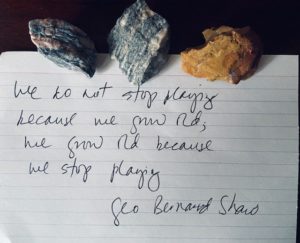
January 15, 2020 No Comments





